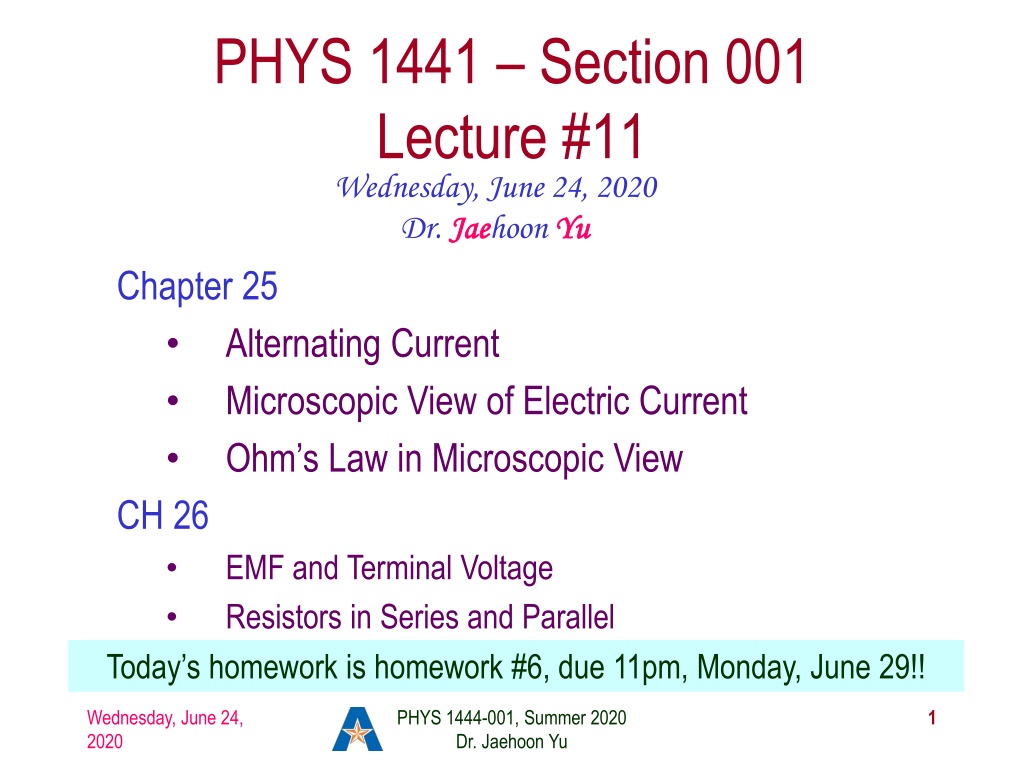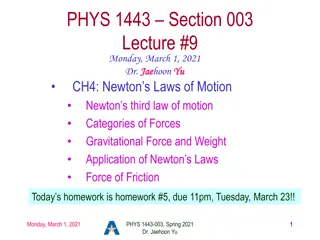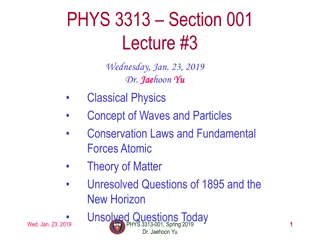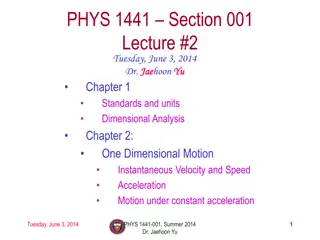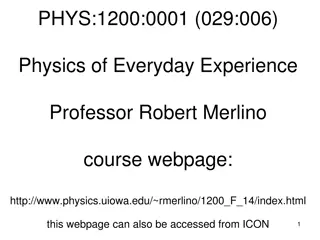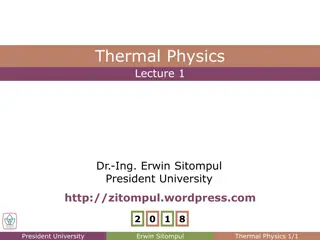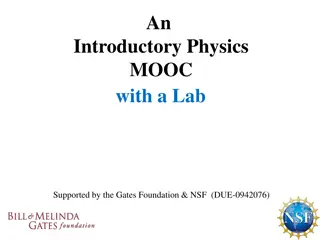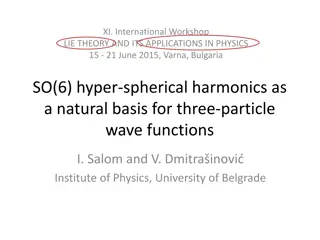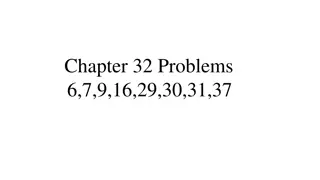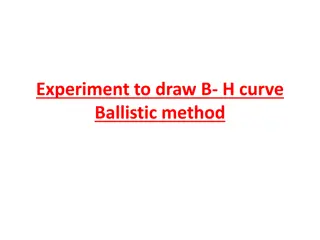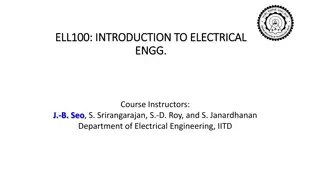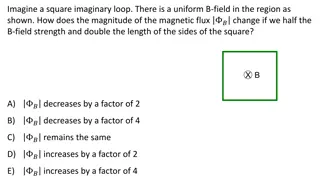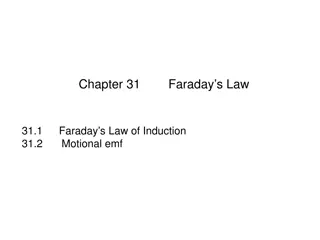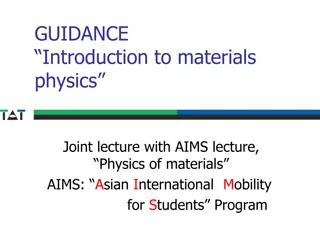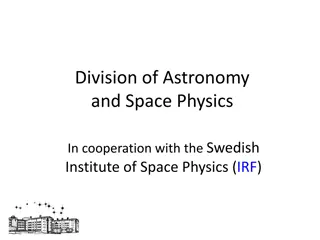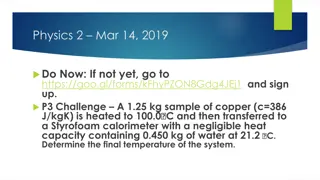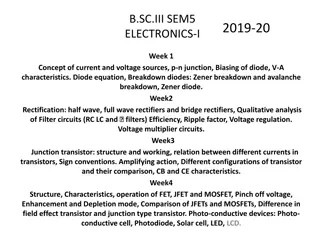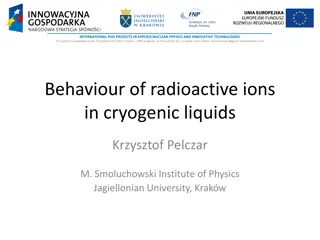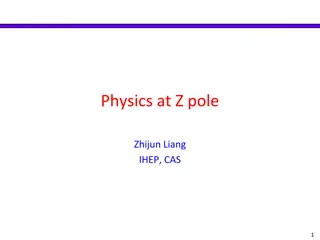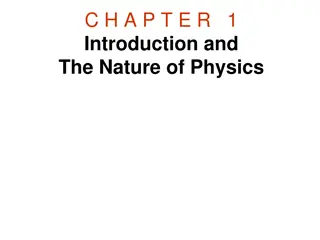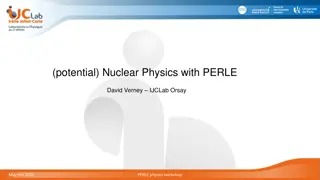Physics Lecture Summary: AC, EMF, and Special Project Reminder
In today's physics lecture, Dr. Jae Jaehoon Yu discussed alternating current (AC) and EMF, emphasizing the microscopic view of electric current and Ohm's Law. The lecture included details on resistors in series and parallel circuits. An upcoming quiz on Chapter 25 was announced, along with a mid-term grade discussion. Additionally, a special project involving power consumption and electricity cost estimation for home devices was introduced, with a submission deadline of June 30.
Download Presentation

Please find below an Image/Link to download the presentation.
The content on the website is provided AS IS for your information and personal use only. It may not be sold, licensed, or shared on other websites without obtaining consent from the author. Download presentation by click this link. If you encounter any issues during the download, it is possible that the publisher has removed the file from their server.
E N D
Presentation Transcript
PHYS 1441 Section 001 Lecture #11 Wednesday, June 24, 2020 Dr. Jae Jaehoon Yu Chapter 25 Alternating Current Microscopic View of Electric Current Ohm s Law in Microscopic View CH 26 EMF and Terminal Voltage Resistors in Series and Parallel Today s homework is homework #6, due 11pm, Monday, June 29!! Yu Wednesday, June 24, 2020 PHYS 1444-001, Summer 2020 Dr. Jaehoon Yu 1
Announcements We will have a mid-term grade discussion tomorrow, Thursday, June 25. We will have a class till 11:30am, followed by the discussion on zoom Will use breakout rooms, one student in each room (must stay connected to zoom!) Last name A K:11:30 12:00 Last name L Y: 12:00 12:30 Quiz #3 on Quest Beginning of the class coming Monday, June 29 Covers CH25.4 what we finish tomorrow BYOF Mid-term exam results Class average: 55.2/102 Equivalent to 54.1/100 (Term 1: 63.4/100) Top score: 102/102 Warning: I will mark those of you still connected at the end of the class but not answering to my call missing the class Wednesday, June 24, 2020 PHYS 1444-001, Summer 2020 Dr. Jaehoon Yu 2
Reminder: Special Project #4 Make a list of the power consumption and the resistance of all electric and electronic devices at your home and compile them in a table. (10 points total for the first 10 items and 0.5 points each additional item.) Estimate the cost of electricity for each of the items on the table using your own electric cost per kWh (if you don t find your own, use $0.12/kWh) and put them in the relevant column. (5 points total for the first 10 items and 0.2 points each additional items) Estimate the the total amount of energy in Joules and the total electricity cost per day, per month and per year for your home. (8 points) Due: Beginning of the class Tuesday, June 30 Scan all pages of your special project into the pdf format Save all pages into one file with the filename SP4-YourLastName-YourFirstName.pdf Send me the file in an email with the subject SP4 Submission Wednesday, June 24, 2020 PHYS 1444-001, Summer 2020 Dr. Jaehoon Yu 3
Wednesday, June 24, 2020 PHYS 1444-001, Summer 2020 Dr. Jaehoon Yu 4
Alternating Current Does the direction of the flow of current change while a battery is connected to a circuit? No. Why? Because its source of potential difference stays put. This kind of current is called the Direct Current (DC), and it does not change its direction of flow while the battery is connected. How would DC look as a function of time? (poll 12) A straight line Electric generators at electric power plant produce alternating current (AC) AC reverses direction many times a second (poll 12) AC is sinusoidal as a function of time Most the currents supplied to homes and business are AC. Wednesday, June 24, 2020 PHYS 1444-001, Summer 2020 Dr. Jaehoon Yu 5
The Alternating Current The voltage produced by an AC electric generator is sinusoidal (whose law? Poll 13) This is why the current is sinusoidal Voltage produced can be written as V t ( )= V0sin2p ft=0sin V t What are the maximum and minimum voltages? V0 ( V0) and 0 The potential oscillates between +V0 and V0, the peak voltages or amplitude What is f? The frequency, the number of complete oscillations made per second. What is the unit of f? What is the normal size of f in the US? f=60Hz in the US and Canada. Many European countries have f=50Hz. = f Wednesday, June 24, 2020 PHYS 1444-001, Summer 2020 Dr. Jaehoon Yu 6
Alternating Current Since V=IR, if a voltage V exists across a resistance R, the current I is (poll 13) V I R R What is this? V = = 0sin2 = ft 0sin I t What are the maximum and minimum currents? I0 ( I0) and 0. The current oscillates between +I0 and I0, the peak currents or amplitude. The current is positive when electron flows to one direction and negative when they flow opposite. AC is as many times positive as negative. What s the average current? Zero. So there is no power and no heat is produced in a heater? Yes there is! The electrons actually flow back and forth, so power is delivered. Wednesday, June 24, 2020 PHYS 1444-001, Summer 2020 Dr. Jaehoon Yu 7
Power Delivered by Alternating Current AC power delivered to a resistance is: = = 2 2 0 2 sin P I R I R t Since the current is squared, the power is always positive The average power delivered is Since the power is also P=V2/R, we can obtain 1 2 2 0 = P I R 2 V 1 2 ( ) 0 = 2 2 = P sin P V R t Average power 0 R The average of the square of current and voltage are important in calculating power: 1 2 I2=1 2 2 = 2 V V 2I0 0 Wednesday, June 24, 2020 PHYS 1444-001, Summer 2020 Dr. Jaehoon Yu 8
Power Delivered by Alternating Current The square root of each of these are called root-mean-square, or rms: 2 0 0 0.707 2 V I 2 0 2 = = = = = = 0.707 V V V I I I 0 rms rms rms values are sometimes called the effective values These are useful quantities since they can substitute current and voltage directly in power, as if they are in DC 1 2 2 2 V V 1 2 2 0 2 rms = = P I R I R = 0 = = rms R P I rms rms V P R In other words, an AC of peak voltage V0 or peak current I0 produces as much power as DC voltage of Vrms or DC current Irms. So normally, rms values in AC are specified or measured. US uses 115V rms voltage. What is the peak voltage? Europe uses 240V 2rms V = 2 240 340 V V = 0 V = = 2 115 = 2rms V 162.6 V V 0 V = Wednesday, June 24, 2020 PHYS 1444-001, Summer 2020 Dr. Jaehoon Yu 9
Example 25 13 Hair Dryer. (a) Calculate the resistance and the peak current in a 1000-W hair dryer connected to a 120-V AC line. (b) What happens if it is connected to a 240-V line in Britain? The rms current is: rms I = V The peak current is: P =1000 120 W V = 8.33 A rms 0I = 2rms = 2 8.33 I = 11.8 A A 1000 8.33 W A P Thus the resistance is: = 14.4 =( R = ) 2 2 rms I (b) If connected to 240V in Britain The average power provide by the AC in UK is 2 rms V R 14.4 =( ) 2 240 V P = = 4000 W So? The heating coils in the dryer will melt! Wednesday, June 24, 2020 PHYS 1444-001, Summer 2020 Dr. Jaehoon Yu 10
Microscopic View of Electric Current When voltage is applied across the ends of a wire Electric field is generated by the potential difference Electrons feel the force and get accelerated Electrons soon reach to a steady average speed due to collisions with atoms in the wire, called drift velocity, vd The drift velocity is normally much smaller than electrons average random speed. Wednesday, June 24, 2020 PHYS 1444-001, Summer 2020 Dr. Jaehoon Yu 11
Microscopic View of Electric Current The drift velocity of electrons in a wire is only about 0.05mm/s. How could we get light turned on immediately then? While the electrons in the wire travels slow, the electric field travels essentially at the speed of light. Then what is all the talk about electrons flowing through? It is just like water. When you turn on the facet, water flows right off the facet despite the fact that the water travels slow. Electricity is the same. Electrons fill the conductor wire and when the switch is flipped on or a potential difference is applied, the electrons close to the positive terminal flows into the bulb. Interesting, isn t it? Why is the field travel at the speed of light then? Wednesday, June 24, 2020 PHYS 1444-001, Summer 2020 Dr. Jaehoon Yu 12
Superconductivity At the temperature near absolute 0K, resistivity of certain material becomes 0. This state is called the superconducting state. Observed in 1911 by H. K. Onnes when he cooled mercury to 4.2K (- 269oC). Resistance of mercury suddenly dropped to 0. In general superconducting materials become superconducting below a transition temperature (Tc). The highest temperature superconductivity seen is 160K First observation above the boiling temperature of liquid nitrogen is in 1987 at 90k observed from a compound of yttrium, barium, copper and oxygen. Since much smaller amount of material can carry just as much current more efficiently, superconductivity can make electric cars more practical, computers faster, and capacitors store higher energy Wednesday, June 24, 2020 PHYS 1444-001, Summer 2020 Dr. Jaehoon Yu 13
Critical Temperature of Superconductors Wednesday, June 24, 2020 PHYS 1444-001, Summer 2020 Dr. Jaehoon Yu 14
Electric Hazards: Leakage Currents How does one feel shock by electricity? Electric current stimulates nerves and muscles, and we feel a shock The severity of the shock depends on the amount of current, how long it acts and through what part of the body it passes Electric current heats the tissue and can cause burns Currents above 70mA on a torso for a second or more is fatal, causing heart to function irregularly, ventricular fibrillation . A dry human body between two points on the opposite side of the body is about 104 to 106 . But when wet, it could be 103 . A person in good contact with the ground who touches 120V DC line with wet hands can get the current: Could be lethal =120 1000 I =V V = 120 mA R Wednesday, June 24, 2020 PHYS 1444-001, Summer 2020 Dr. Jaehoon Yu 15
EMF and Terminal Voltage What do we need to have current in an electric circuit? A device that provides a potential difference, such as a battery or a generator They normally convert some types of energy into the electric energy These devices are called source of electromotive force (emf) This is does NOT refer to a real force . Potential difference between terminals of an emf source, when no current flows to an external circuit, is called the emf (E) of the source. The battery itself has some internal resistance (r) due to the flow of charges in the electrolyte Why does the headlight dim when you start the car? The starter needs a large amount of current but the battery cannot provide charge fast enough to supply current to both the starter and the headlight Wednesday, June 24, 2020 PHYS 1444-001, Summer 2020 Dr. Jaehoon Yu 16
EMF and Terminal Voltage Since the internal resistance is inside the battery, we can never separate them out. So the terminal voltage difference is Vab=Va-Vb. When no current is drawn from the battery, the terminal voltage equals the emf which is determined by the chemical reaction; Vab= E. However when the current I flows naturally from the battery, there is a voltage drop due to the internal resistance which is equal to Ir. Thus the actual delivered terminal voltage is = V Ir ab Wednesday, June 24, 2020 PHYS 1444-001, Summer 2020 Dr. Jaehoon Yu 17
Resistors in Series Resistors are in series when two or more resistors are connected end to end These resistors represent simple resistors in circuit or electrical devices, such as light bulbs, heaters, dryers, etc What is common in a circuit connected in series? Current is the same through all the elements in series Potential difference across every element in the circuit is V1=IR1, V2=IR2 and V3=IR3 Since the total potential difference is V, we obtain V=IReq=V1+V2+V3=I(R1+R2+R3) Thus, Req=R1+R2+R3 = R R Resistors in series eq i i Wednesday, June 24, 2020 PHYS 1444-001, Summer 2020 Dr. Jaehoon Yu 18 When resistors are connected in series, the total resistance increases and the current decreases.
Energy Losses in Resistors Why is it true that V=V1+V2+V3? What is the potential energy loss when charge q passes through resistors R1, R2 and R3 U1=qV1, U2=qV2, U3=qV3 Since the total energy loss should be the same as the total energy provided to the system, we obtain U=qV= U1+ U2+ U3=q(V1+V2+V3) Thus, V=V1+V2+V3 Wednesday, June 24, 2020 PHYS 1444-001, Summer 2020 Dr. Jaehoon Yu 19
Example 26 1 Battery with internal resistance. A 65.0- resistor is connected to the terminals of a battery whose emf is 12.0V and whose internal resistance is 0.5- . Calculate (a) the current in the circuit, (b) the terminal voltage of the battery, Vab, and (c) the power dissipated in the resistor R and in the battery s internal resistor. (a) Since ab V Ir = We obtain + = IR = Ir V ab What is this? 12.0 + V = = I = 0.183 A Solve for I I A battery or a source of emf. 65.0 0.5 R r =12.0 = V = 0.183 0.5 11.9 Ir V A V (b) The terminal voltage Vab is ab 2I R =( 2I r = ( ) ) 2 = 0.183 65.0 2.18 P = A W (c) The power dissipated in R and r are 2 P = = 0.183 0.5 0.02 A W Wednesday, June 24, 2020 PHYS 1444-001, Summer 2020 Dr. Jaehoon Yu 20
Resistors in Parallel Resistors are in parallel when two or more resistors are connected in separate branches Most the house and building wirings are arranged this way. What is common in a circuit connected in parallel? The voltage is the same across all the resistors. The total current that leaves the battery, is however, split. The current that passes through every element is I1=V/R1, I2=V/R2, I3=V/R3 Since the total current is I, we obtain I=V/Req=I1+I2+I3=V(1/R1+1/R2+1/R3) Thus, 1/Req=1/R1+1/R2+1/R3 When resistors are connected in parallel, the total resistance decreases and the current increases. 1 1 R = resistors in parallel R eq i i Wednesday, June 24, 2020 PHYS 1444-001, Summer 2020 Dr. Jaehoon Yu 21
Resistor and Capacitor Arrangements = Parallel Capacitor arrangements C C eq i i 1 1 R = Parallel Resistor arrangements R eq i i 1 1 = Series Capacitor arrangements C C eq i i = Series Resistor arrangements R R eq i i Wednesday, June 24, 2020 PHYS 1444-001, Summer 2020 Dr. Jaehoon Yu 22
Example 26 2 Series or parallel? (a) The light bulbs in the figure are identical and have identical resistance R. Which configuration produces more light? (b) Which way do you think the headlights of a car are wired? (a) What are the equivalent resistances for the two cases? 2 R 1 R = = = R R 2R Parallel So Series R eq eq 2 eq The bulbs get brighter when the total power transformed is larger. 2 V R 2 R So parallel circuit provides brighter lighting. (b) Car s headlights are in parallel to provide brighter lighting and also to prevent both lights going out at the same time when one burns out. 2 2 2 V R 2V V IV = PP = = SP = =4SP = IV = series parallel R eq eq So what is bad about parallel circuits? Uses more energy in a given time. Wednesday, June 24, 2020 PHYS 1444-001, Summer 2020 Dr. Jaehoon Yu 23
Example 26 5 Current in one branch. What is the current flowing through the 500- resistor in the figure? What do we need to find first? We need to find the total current. To do that we need to compute the equivalent resistance. 1 1 12 3500 3500 12 1 R = + = = Req of the small parallel branch is: Req of the circuit is: P 500 + V R 700 = R = P 3500 12 = R + 400 400 292 =12 692 692 eq Thus the total current in the circuit is = 17 mA I = eq 3 17 10 292 4.96V = The voltage drop across the parallel branch is V = IR = bc P The current flowing across 500- resistor is therefore V R 4.96 500 = 3 = = = bc V I 9.92 10 9.92 mA 500 bc = 17 9.92 7.08mA = = I I I What is the current flowing 700- resistor? 700 500 Wednesday, June 24, 2020 PHYS 1444-001, Summer 2020 Dr. Jaehoon Yu 24
